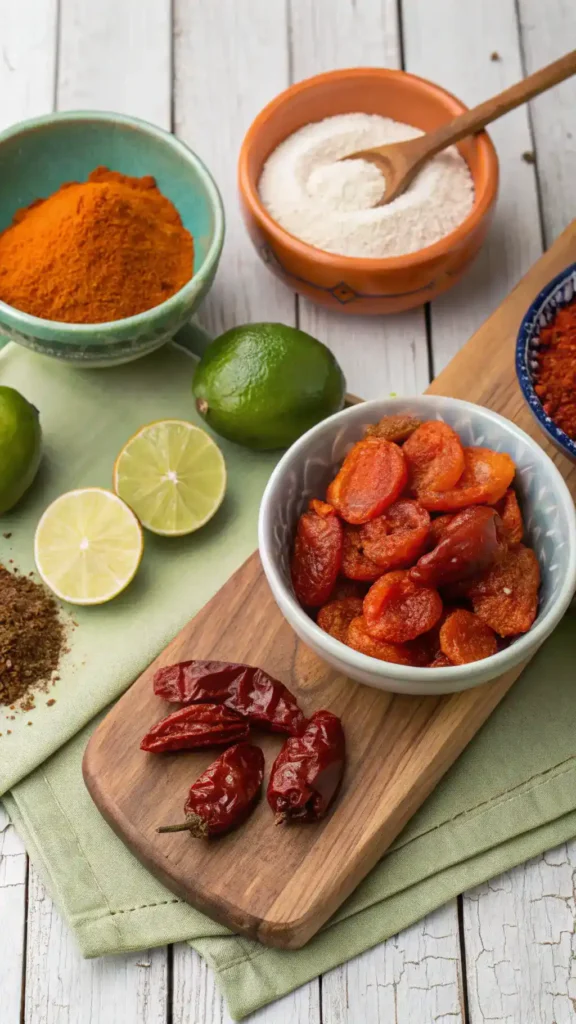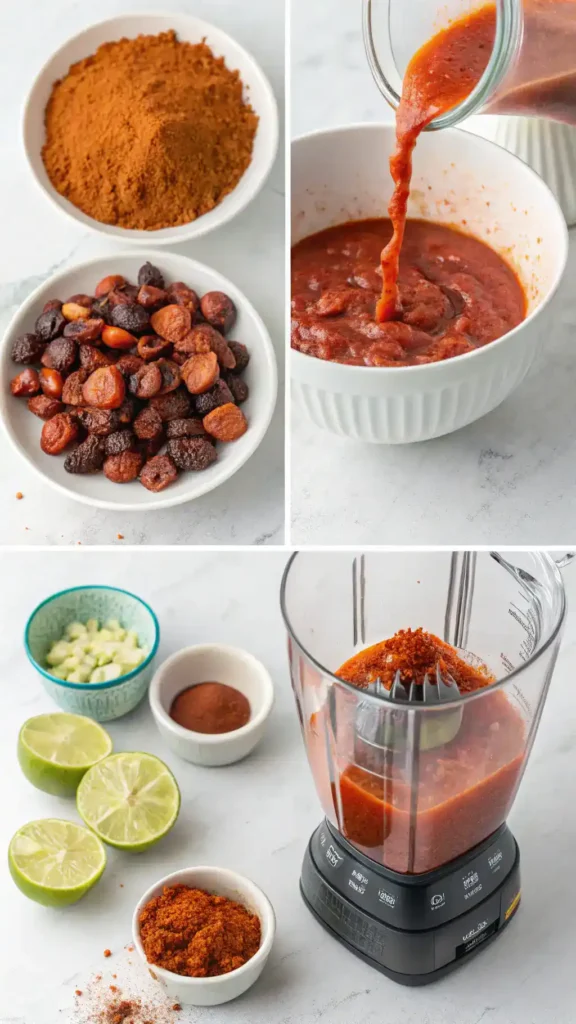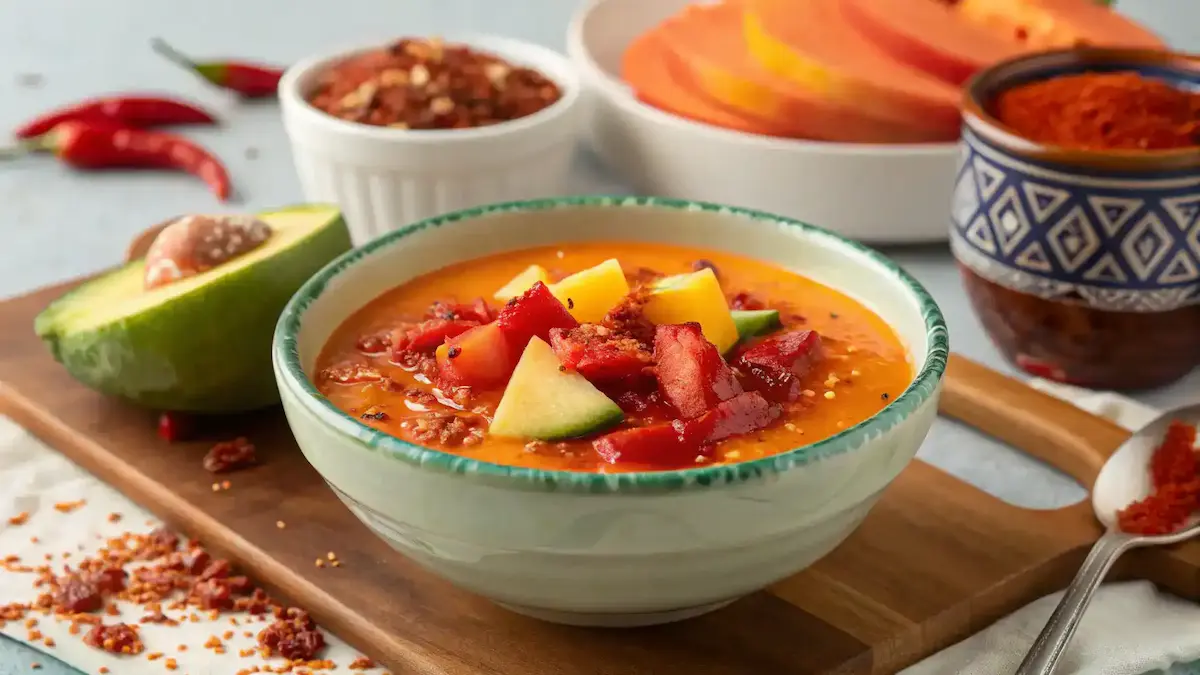Have you ever wondered how to create that irresistible flavour of chamoy right in your own kitchen? This versatile condiment not only enhances the taste of your favourite dishes but also offers numerous health benefits. By making your own chamoy recipe from scratch, you can ensure that you are using natural ingredients, avoiding preservatives, and enjoying a healthier alternative to store-bought versions. Moreover, this delightful sauce adds a unique sweet, sour, and spicy profile to snacks, fruits, and savoury dishes alike. So, let’s dive into the world of homemade chamoy recipe and discover how easy it is to elevate your culinary creations!
Table of Contents
Table of Contents

chamoy recipe
Equipment
- 1 Blender For blending the ingredients.
- 1 Saucepan For simmering the chamoy.
Ingredients
Dried Fruits
- 1 cup Dried apricots or mangoes Soaked in warm water.
Spices
- 1 teaspoon Chili powder or flakes For heat.
Liquids
- 1/4 cup Fresh lime juice For a zesty kick.
- 1/4 cup Sugar or agave syrup To balance sweetness.
- 1 pinch Salt To enhance flavor.
- as needed cup Water To adjust consistency.
Instructions
Preparation
- Soak the dried fruits in warm water for about 15-20 minutes to soften them.
Blending
- Drain the water and blend the softened fruits with chili powder, lime juice, sugar, and salt until smooth.
Adjusting Consistency
- Add water gradually to achieve the desired pourable consistency.
Simmering
- Pour the mixture into a saucepan and simmer on low heat for 5-10 minutes to enhance flavors.
Final Adjustments
- Taste and adjust sweetness or spiciness as needed.
Notes
| Calories | Fat | Protein | Carbs |
|---|---|---|---|
| 100 | 0g | 0g | 25g |
Key Benefits
Chamoy recipe is not just a tantalising sauce but also a versatile condiment that brings numerous benefits to your culinary experience. Firstly, it enhances the flavour of various dishes, adding a delightful sweet, sour, and spicy profile. Additionally, making chamoy from scratch allows you to control the ingredients, ensuring that you use natural and healthier options compared to store-bought versions, which may contain preservatives and artificial flavours. Enjoying chutney can elevate your snacks, fruits, and even savoury dishes, making it an essential addition to your kitchen.
Here are some key benefits of the chamoy recipe:
- Health Benefits: Chamoy can be made with natural ingredients, such as dried fruits and lime juice, which provide vitamins and antioxidants. For instance, dried fruits like apricots and mangoes are rich in fibre and essential nutrients, supporting digestive health and boosting your immune system.
- Flavour Enhancement: This sauce adds a unique flavour profile to your meals. The combination of sweet, sour, and spicy elements can transform ordinary dishes into extraordinary culinary experiences.
- Versatile Condiment: Chamoy can be used in various ways, from drizzling over fruits to serving as a dipping sauce for snacks. Its versatility makes it a staple in many kitchens.
- Homemade vs. Store-Bought: By making chamoy at home, you avoid the additives and preservatives often found in commercial products. This not only ensures better taste but also promotes healthier eating habits.
- Natural Ingredients: Using natural ingredients in your chamoy recipe means you can customise flavours and sweetness levels to suit your preferences, making it a healthier choice overall.
In conclusion, the chamoy recipe offers a delightful way to enhance your meals while providing health benefits through its natural ingredients. So, why not give it a try and enjoy the delicious flavours it brings to your table?
Ingredients
To create the perfect chamoy recipe, you’ll need a selection of simple yet flavorful ingredients. Start with dried fruits like apricots or mangoes, which serve as the base for your sauce. These fruits not only add natural sweetness but also impart a rich, fruity aroma that will tantalise your senses.
Next, you will require chilli powder or flakes to provide that signature heat. The warmth of the chilli complements the sweetness of the fruit beautifully, creating a delightful contrast. Additionally, fresh lime juice is essential for a zesty kick, brightening the overall flavour profile.
Sweeteners like sugar or agave syrup will balance the flavours, adding just the right amount of sweetness. A pinch of salt enhances the overall taste, bringing all the elements together harmoniously. Lastly, don’t forget to add water to achieve your desired consistency, ensuring your chamoy is perfectly pourable.
Here’s a quick rundown of the ingredients you’ll need for your chamoy recipe:

- Dried fruit: Apricots or mangoes
- Chilli powder or flakes: For heat
- Lime juice: For a zesty kick
- Sugar or agave syrup: To balance the sweetness
- Salt: To enhance flavour
- Water: To adjust consistency
How to Make Chamoy Recipe
Making chamoy from scratch is a straightforward process that yields delicious results. Follow these simple steps to create your own flavorful chamoy recipe:
- Soak the Dried Fruits: Begin by soaking your dried fruits, such as apricots or mangoes, in warm water for about 15-20 minutes. This step softens the fruits, making them easier to blend.
- Blend the Ingredients: Once the fruits are softened, drain the water and transfer them to a blender. Add chilli powder, fresh lime juice, sugar or agave syrup, and a pinch of salt. Blend until the mixture is smooth and well combined.
- Adjust the Consistency: If the mixture is too thick, gradually add water, one tablespoon at a time, until you reach your desired consistency. Remember, the chamoy should be pourable but not too runny.
- Simmer for Depth of Flavour: For a deeper flavour, pour the blended mixture into a saucepan and simmer on low heat for about 5-10 minutes. This step enhances the flavours and helps meld the ingredients together.
- Taste and Adjust: After simmering, taste your chamoy and adjust the seasoning as needed. If you prefer it sweeter, add more sugar; if you want it spicier, add more chilli powder. Balance is key!

By following these steps, you’ll have a delicious homemade chamoy recipe that enhances the flavour of your favourite snacks and dishes. Enjoy the satisfaction of making this versatile condiment from scratch!
Pro Tips, Variations, and Common Problems
To elevate your chamoy recipe, consider experimenting with different dried fruits such as plums or even adding a splash of fruit juice for extra flavour. Additionally, if your chamoy turns out too thick, simply add more water until you reach your desired consistency. Common mistakes include using overly sweet fruits or not balancing the acidity; therefore, always taste as you go! If you encounter issues with texture, blending thoroughly can help achieve a smoother sauce. Store your chamoy in an airtight container to maintain freshness.
Flavor Variations
For a unique twist, try incorporating different spices such as cinnamon or even a hint of ginger. You can also adjust the heat level by varying the amount of chili powder or flakes. Furthermore, adding a bit of honey instead of sugar can create a richer flavor profile.
Texture Tips
If your chamoy is too chunky, blend it longer or strain it through a fine mesh sieve. Conversely, if it’s too runny, simmer it on low heat to thicken. Remember, achieving the perfect consistency is key to a delightful chamoy recipe.
Ingredient Substitutions
In case you don’t have dried apricots or mangoes, feel free to use other dried fruits like cherries or figs. For a healthier sweetener, agave syrup works wonderfully. If you prefer a sugar-free option, consider using stevia or monk fruit sweetener.
Storage Advice
To keep your homemade chamoy fresh, store it in an airtight container in the refrigerator, where it can last for up to two weeks. If you want to extend its shelf life, consider freezing it in ice cube trays for easy portioning. When you’re ready to use it, simply thaw the desired amount in the fridge or at room temperature. Reheating is generally unnecessary, but if you prefer it warm, gently heat it on the stovetop while stirring to maintain its flavor and consistency.
Serving Suggestions
Chamoy is incredibly versatile and can be used in various ways to elevate your culinary experience. Here are some delightful serving suggestions that will not only impress your guests but also enhance the flavors of your dishes:
- Drizzle over Fresh Fruits: Pour chamoy over slices of juicy mango, pineapple, or watermelon. The sweet, sour, and spicy notes of the chamoy will complement the natural sweetness of the fruits, creating a refreshing snack.
- Pair with Snacks: Serve chamoy alongside tortilla chips or popcorn for a unique twist. The bold flavors will transform ordinary snacks into a gourmet experience that everyone will love.
- Creative Dipping Sauce: Use chamoy as a dipping sauce for fresh veggies or grilled meats. This unexpected pairing adds a burst of flavor that will surprise and delight your guests.
- Garnish for Savory Dishes: Drizzle chamoy over tacos, grilled chicken, or roasted vegetables. This condiment enhances the overall flavor profile, making your dishes even more delicious.
- Party Platter Star: Incorporate chamoy into your party platters. It can be a fun addition to cheese boards or charcuterie spreads, inviting guests to explore new flavor combinations.
By using these serving suggestions, you can showcase your homemade chamoy recipe in a way that is both visually appealing and delicious. Whether you’re hosting a gathering or enjoying a quiet evening at home, chamoy will surely elevate your culinary creations!
Preserving and Reheating Your Chamoy Recipe
To keep your homemade chamoy fresh and flavorful, proper storage is essential. Firstly, store your chamoy in an airtight container in the refrigerator. This method allows it to stay fresh for up to two weeks. If you want to extend its shelf life even further, consider freezing it. You can pour the chamoy into ice cube trays for easy portioning.
Once frozen, transfer the cubes to a freezer-safe bag or container. In this way, it can last for up to three months. When you’re ready to use it, simply thaw the desired amount in the fridge or at room temperature. Additionally, always remember to check for any signs of spoilage, such as off smells or discoloration, to ensure food safety. This precaution helps prevent bacterial growth and keeps your chamoy safe to enjoy.
Reheating Methods
Reheating your chamoy is generally unnecessary, but if you prefer it warm, there are effective methods to do so without compromising its taste and texture. For stovetop reheating, pour the desired amount into a small saucepan. Heat it over low to medium heat, stirring gently until warmed through. This method helps maintain its consistency.
Alternatively, you can use the microwave. Place the chamoy in a microwave-safe bowl and cover it loosely with a microwave-safe lid or plate. Heat it in short intervals of 15 to 20 seconds, stirring in between, until it reaches your desired warmth. This approach prevents overheating and drying out. If you find that the chamoy has thickened, add a splash of water or lime juice to refresh it. This simple addition will help restore its original texture and flavor.
Conclusion
In conclusion, making chamoy from scratch is not only a rewarding culinary endeavor but also a fantastic way to enhance your meals with bold flavors. By using natural ingredients, you can enjoy a healthier version of this beloved condiment. Whether you’re drizzling it over fruits or using it as a dipping sauce, homemade chamoy will surely elevate your dishes and impress your guests. So, why not give this chamoy recipe a try? It’s simple, versatile, and perfect for anyone looking to get creative in the kitchen. Remember, cooking should be fun, and experimenting with flavors is part of the joy.
I encourage you to share your results or ask any questions you may have. Additionally, feel free to explore different variations or pairings to make this recipe your own. After all, the satisfaction of creating something delicious from scratch is truly unmatched!
FAQs
Here are some common questions about making chamoy, along with helpful answers to enhance your culinary experience.
Q1: Can I use fresh fruits instead of dried fruits for chamoy?
While fresh fruits can add flavor, they won’t provide the same texture or sweetness as dried fruits. Dried fruits like apricots or mangoes are essential for achieving the right consistency and flavor in your chamoy recipe.
Q2: How can I adjust the spiciness of my chamoy?
If you find your chamoy too spicy, simply add more sweetener, like sugar or agave syrup, to balance the heat. Alternatively, you can reduce the amount of chili powder or flakes in your chamoy recipe to suit your taste.
Q3: What should I do if my chamoy is too thick?
If your chamoy turns out thicker than desired, don’t worry! Just add a little water, a tablespoon at a time, and blend until you reach your preferred consistency. This way, you can ensure it’s perfect for drizzling or dipping.
Q4: How long can I store homemade chamoy?
You can store your homemade chamoy in an airtight container in the refrigerator for up to two weeks. For longer storage, consider freezing it in ice cube trays. This method allows you to use it in portions whenever you need it.
Q5: Can I make chamoy without sugar?
Absolutely! You can substitute sugar with natural sweeteners like agave syrup or honey. This way, you can enjoy a healthier version of your chamoy recipe while still achieving that delightful sweetness.
Your Flavorful Feedback
There are no reviews yet. Be the first one to write one.

